Starter Cultures.
Whey.
Vinegar.
Celery Juice.
Brine from a previous batch (Back-Slopping).
There you have it.
Five ingredients I never use in my sauerkraut or fermented vegetables.
Not only can you safely ferment without them, but your ferments will have a
Greater depth of flavor, and you will
Save yourself money, and
Save yourself time, if
you instead transform that modest, humble head of cabbage into a flavor-packed nutritional powerhouse by the ancient practice of lacto-fermentation.
- Lacto-Fermentation (Wild Fermentation) vs. Cultured Fermentation
- 1. Do You Need to Use a Starter Culture to Make Your Ferment Safe?
- 2. Why not use Whey for Vegetable Fermentation?
- 3. Can You Add Vinegar to Give Your Ferment Tang?
- 4. Should You Use Celery Juice for No-Salt Sauekraut?
- 5. What’s Wrong with Using a Bit of Brine from a Previous Batch of Sauerkraut?
- What to Use Instead of Starter Cultures, Whey, Vinegar, Celery Juice or Leftover Brine?
Lacto-Fermentation (Wild Fermentation) vs. Cultured Fermentation
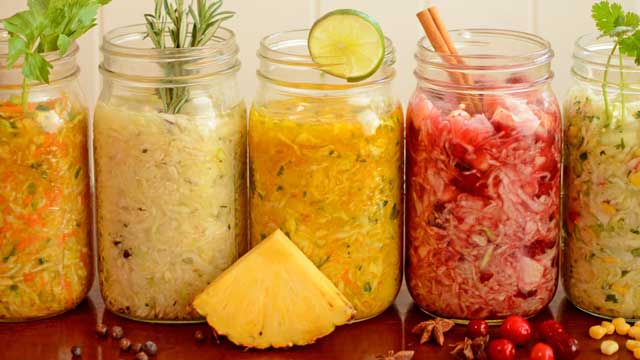 First off…
First off…
Let’s make sure you understand what lacto-fermentation is. Then you’ll understand why starter cultures are not necessary.
Wild fermentation,
Lacto-fermentation, or
Lactic-acid fermentation –
as I promote in my recipes – uses the native bacteria that are present on the vegetables you are fermenting to culture the food.
“Lactic acid” is used to name this type of fermentation, not because it contains any dairy (it doesn’t), but because of the lactic acid bacteria (LAB) that make everything happen. These powerful bacteria are called lactic-acid bacteria because they produce lactic acid. So logical!
This lactic acid gives ferments a sour taste – much like vinegar – and acts as a preservative for your sauerkraut or fermented vegetables.
Lactic acid bacteria are present in our soil and therefore found on anything that grows in the earth.
You’ll also see the term “wild-fermentation” used because fermentation happens just fine without anything else – oops, salt – but the bacteria that occur naturally on the vegetables you’re fermenting.
You do not need to purchase starters.
You do not need to drip yogurt to get whey.
You do not need to juice celery.
You just need to give the bacteria the home they like – a brine of 2% – and let the trillions of members of our microbial world do their thing.
This is in contrast to “cultured” foods, where you do need to add a culture of some sort to make the magic happen.
Kombucha, water kefir and milk kefir are all fermented with the addition of a culture: a SCOBY (Symbiotic Culture Of Bacteria and Yeasts). The bacteria work together to create the actual physical SCOBY along with consuming the sugar in the sweetened tea (Kombucha), sweetened juice (water kefir) or milk sugars (milk kefir) and producing the finished product.
Or with yogurt, where a dollop of yogurt (from a previous batch) is mixed into warmed milk and left to culture for 8 to 24 hours in a warm place. During this time, the bacteria present in the yogurt go to work for us, growing and multiplying, to turn the milk into a thick, creamy product with a soured tang – more yogurt.
Now, on to explain why a starter culture, whey, vinegar, celery juice or back-slopped brine is recommended for use in vegetable ferments. Even if you never intend to use these methods, read on. You’ll better understand what is happening in that jar of yours that is fermenting on your countertop.
1. Do You Need to Use a Starter Culture to Make Your Ferment Safe?

Started cultures are dried powders of various strains of bacteria that are used to inoculate your ferment. The powder is usually dissolved in water before being thoroughly mixed with your prepared cabbage and vegetables.
I must be honest and confess that I have never used a starter culture to make sauerkraut. When I first started fermenting, the only starter cultures available contained ingredients – such as skim milk powder – that I did not want in my sauerkraut. Since then, however, starter cultures have improved even to the point of using specific strains of bacteria to produce higher levels of specific nutrients, K2 for example.
I still am not drawn to them and prefer the simplicity of just cabbage, salt and time.
Starter Cultures for Fermentation & Why Some Recommend Their Use:
- Speed up the fermentation process.
- Control the fermentation process.
- Safety.
“You can never be sure that there are enough naturally occurring lactic-acid bacteria on your vegetables to neutralize and crowd out pathogenic bacteria such as e Coli, salmonella, listeria.“
This was emphasized in one company’s video. This is fear-mongering to sell starters. Pathogenic bacteria can not survive in the acidic fermentation environment.
Starter Cultures for Fermentation & Why I Don’t Use Them:
- Use of non-bacterial ingredients you might not want in your ferment.
Here are some that I’ve seen listed on various starter cultures:
Organic maltodextrin, as a carrier.
Organic tapioca sugar as food for the bacteria.
Inulin, a prebiotic fiber derived from chicory root.
Lactic yeasts.
Skim milk powder.
Microcrystalline cellulose.
Silicone dioxide. - Cost.
A packet of starter cultures costs anywhere from $3-4 and is recommend for 2-5 pounds of vegetables. Such money is better spent on a weight and airlock system for fermentation that will shift your sauerkraut making into a fun and easy adventure for years to come. - Not reusable.
I find it strange to have to buy a culture each time I want to ferment. Nature provides you with all the bacteria you need to successfully ferment… batch after batch. - May interfere with the natural – and ideal – progression of bacterial stages.
- Flavor changes.
By changing the fermentation process, starter cultures change the flavors of your fermented vegetable. - Shelf life. 12 months generally.
- Not necessary for vegetable ferments.
Vegetables have all the necessary lactic-acid bacteria already on them. - Commercially isolated strains of bacteria specifically chosen in a lab.
These are the strains of bacteria in some popular starter cultures:
Caldwell’s Starter Culture: lactobacillus plantarum, leuconostoc mesenteroides, pediococcus acidilactici.
Cutting Edge Starter Culture: lactobacillus plantarum, leuconostoc mesenteroides, pediococcus acidilactici.
Body Ecology Starter Culture: lactobacillus plantarum, pediococcus acidolactici, leuconostoc cremoris.
When You Need to Use a Starter Culture
UPDATE (September 8, 2016): In the few days after I published this post, questions came in that brought to light a couple of times when a starter culture might be useful. Here are two situations that I feel call for a starter culture. When you are:
- Fermenting onions.
“Onions are the only vegetable we now of that lack intrinsic lactic-acid bacteria.” – Shockey & Shockey, Fermented Vegetables
If you are fermenting an onion-only relish or chutney, you’ll want to use a starter. You could also use a spoonful of brine from a batch of sauerkraut, but knowing now that the bacteria in that brine – see item number 5, below – are a different set than the bacteria that initiate the fermentation process, I would lean towards using a purchased starter for onions.
Another way to preserve those onions is by pickling them in a citrus brine. Here’s one recipe I found without vinegar: Pickled Red Onions
If I had a choice for starters, I would go with the Body Ecology Starter Culture. It contains isolated bacteria strains (lactobacillus plantarum, pediococcus acidolactici, leuconostoc cremoris) and inulin, a prebiotic that help feed the bacteria in the ferment. - Fermenting low-quality vegetables.
“The quality of fermented vegetables, obtained as a result of natural spontaneous lactic-acid fermentation, is largely dependent on microorganisms present in the raw material. In unfavorable soil-climate conditions, the vegetables may become greatly contaminated with spore-forming bacteria, pathogens or mucous bacteria, yeasts, and molds which may predominate over lactic-acid bacteria, deteriorating the quality of fermented products.” – Polish Journal of Food and Nutrition Sciences: Starter Cultures for Lactic Acid Fermentation of Sweet Pepper, Pattypan Squash, and Tomatoes
This is why you want to use the highest-quality vegetables possible. Those vegetables are feeding the microbes that are doing the work of transforming humble vegetable into a flavor-rich ferment. Learn how to choose top quality cabbage for sauerkraut.
2. Why not use Whey for Vegetable Fermentation?
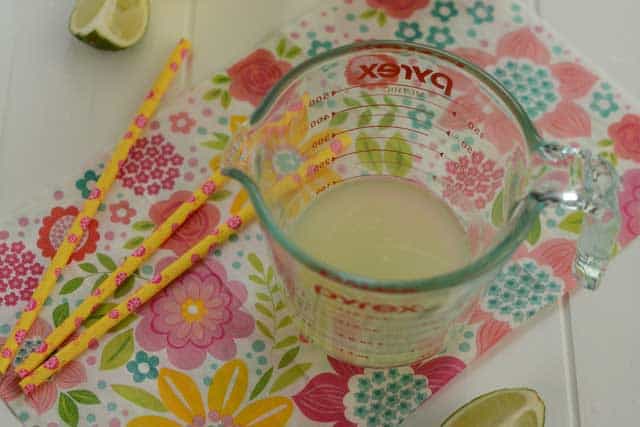
Whey is the cloudy, yellowish liquid you see floating on the surface when you open a tub of yogurt. Whey is also produced when making various kinds of cheeses as an old nursery rhyme captured.
Little Miss Muffett, sat on a tuffet, eating her curds and whey.
Whey is full of beneficial bacteria – depending upon its source – bacteria that you see called for in many fermentation recipes. In fact, when searching the internet for recipes, it is near to impossible to find a fermented vegetable recipe that does not call for whey. This is slowly changing as we better understand what is necessary for an ideal progression of fermentation.
The bacteria present in the whey, however, are different bacteria than would naturally occur on vegetables. Whey is a dairy culture and therefore contains bacteria that live and grow in dairy.
In fact, Amanda Feifer author of a highly recommend book Ferment Your Vegetables, is quite vocal – in all caps – about the use of whey in ferments:
“YOU DO NOT NEED TO USE WHEY, OR ANY OTHER STARTER, TO FERMENT VEGETABLES, AND USING A STARTER COULD ACTUALLY HURT THE QUALITY OF YOUR FERMENT.”
Bacteria Found in Sauerkraut or Cultured Vegetables
These bacteria thrive in soil working together to break down organic matter.
- Leuconostoc mesenteroides
- Lactobacillus brevis
- Pediococcus acidilactici
- Pediococcus pentosaceus
- Lactovacillus Plantarum
Bacteria Found in My Tub of Sagueen Yogurt
These bacteria work together in milk to break down lactose.
- Streptococcus Thermophilus
- Lactobacillus Bulgaricus
- Lactobacillus Acidophilus
- Bifidobacterium Species
Compare those two lists. I don’t know about you, but I see no overlap. By using whey, you are attempting fermentation with a totally different set of bacteria.
Whey for Fermentation & Why Some Recommend It’s Use
- To reduce salt.
Recommended by Sally Fallon in her book Nourishing Traditions as a way to reduce the amount of salt used in a ferment. We have learned a lot about fermentation since her book was first published in 1999.
Many – myself included – were introduced to fermentation by this book. Using the proper amount of salt is key to successful fermentation. Correct brine percentages foster an ideal environment for the right bacteria to thrive and the wrong bacteria to die.
Salt by Weight for Delicious Sauerkraut… Batch after Batch - To prevent waste.
On old-style farms with dairy cows, the cheese-making processes produced a lot of whey. Only so much could be fed to the pigs, so some societies may have used it in their ferments. - Historical basis.
Based upon some historical use of whey, whey was used when salt was not available. - Speed up the fermentation process.
Whey for Fermentation & Why I Don’t Use It
- Changes the end flavor.
More complex flavors are developed when you let the natural progression happen. Some may not taste this change. My first few batches of sauerkraut were made following Sally Fallon’s recipe, which calls for the use of whey. I did not like the end results – mushy with a dirty taste. It took me a while to feel comfortable not using whey, but when I started making sauerkraut without whey, boy did I enjoy the shift in flavors. - Often results in a soft and slimy texture.
Either different bacteria are proliferating or fermentation is proceeding too quickly causing the vegetables to break down. - Changes the fermentation process.
Adding microorganisms to ferments that don’t need them shifts the stages. No research to back this up, but I would assume that the health benefits would likewise shift. - Skipped fermentation stages.
May cause pH to drop too quickly and skip the necessary stages for a fully fermented product. - An unnecessary extra step.
Dripping a tub of yogurt takes time. We all have busy lives. The addition of one extra step may be the breaking point of sauerkraut getting made. Keep it simple. - Whey needs to be super fresh.
Forget about keeping a stash of whey in the fridge for a few weeks. By then the balance of bacteria in the whey have shifted. - Introduces a different set of lactic-acid bacteria.
The lactic-acid bacteria in whey come from dairy, not from vegetables. I eat a variety of fermented foods to innoculate my gut with a diverse range of bacteria. By uses whey in a vegetable ferment, a different set of bacteria are proliferating and there’s less of a chance of consuming lactic-acid bacteria from our soils. - Introduces dairy into a vegetable ferment.
This is not an option for lactose-intolerant individuals.
Is There a Use for Whey?
Yogurt Cream Cheese is a staple in our home. I hang a tub of yogurt and then mix the resulting thick, creamy cheese with salt and spices for a delicious spread. I end up with a few cups of whey. Sadly, it often gets dumped into the compost pile after a few weeks of sitting in the fridge untouched.
How to Make Strained Yoghurt Cream Cheese
Maybe one day, I’ll learn to make cottage cheese with it.
Recipe: Traditional Whey Ricotta
This whey is also great for fermenting items that don’t come with their own beneficial bacteria to make the fermentation process happen.
My fermented coconut water recipe gives options for a variety of cultures, whey is one of them:
Fermented Coconut Water [The Complete Guide]
I’ve also have made many a batch of Rose Hip Hibiscus Soda with it. One of many favorites:
3. Can You Add Vinegar to Give Your Ferment Tang?
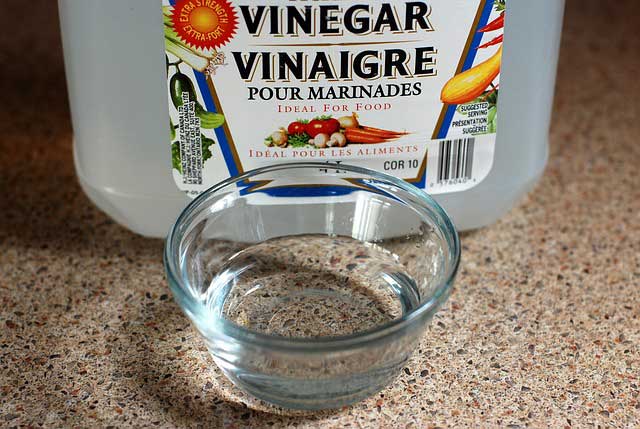
Vinegar is an acidic medium commonly used in commercial pickles, sauerkraut and condiments to give the final product a sour, tangy flavor. Such foods are not fermented but instead “pickled” to make a quick shelf-stable product. A dead product.
The process of natural fermentation – promoted on this site for its countless health benefits – creates its own acidic medium – lactic acid. During fermentation, the starches and sugars in the fermenting vegetables are converted to lactic acid by the bacteria lactobacilli. This lactic acid naturally preserves the food and imparts the tangy sour smell and flavor. Hence, the often seen term of “lacto-fermentation.”
This acidity is why a surefire to sleep at night knowing your ferment is safe to eat is to check if the acids have developed enough to lower the pH to safe levels through the use of pH paper. Read how to do so on my Fermenting Supplies page.
Recipes for “refrigerator” pickles – or “quick” pickles – will call for the use of vinegar. This is a great way to make a shelf-stable product, but if you are wanting to develop great gut health, such pickles offer no probiotic or enzymes to aid in digestion and establish healthy gut flora.
Cucumbers can be naturally fermented without vinegar.
Naturally Fermented Pickles [The Complete Guide]
Vinegar for Fermentation & Why Some Recommend It’s Use
- Makes for a shelf-stable product.
Sauerkraut and pickles that you purchase off a grocery store shelf have been pickled with vinegar and then processed in a hot-water bath. These products are not fermented and hence do not offer the probiotic and enzymatic benefits of lacto-fermented foods. - A quick way to sour a vegetable.
Adding vinegar to your vegetable ferment gives it an instant sour tang. With time, lacto-fermentation develops that same tang by the growth of the lactic-acid bacteria that create lactic acid to preserve and add tang to your ferment.
Vinegar for Fermentation & Why I Don’t Use It
- Pickles the vegetables, does not ferment them.
- Disrupts the ratio of lactic acid created by the bacteria in your ferment to the acetic acid created by fermentation.
By adding vinegar, even raw apple cider vinegar, you stunt the growth of the lactic-acid bacteria resulting in off-texture and flavor and a decrease in the natural preservative qualities of lacto-fermentation. - Lacking in lactic-acid.
Lactic-acid is incredibly beneficial for digestion.
4. Should You Use Celery Juice for No-Salt Sauekraut?
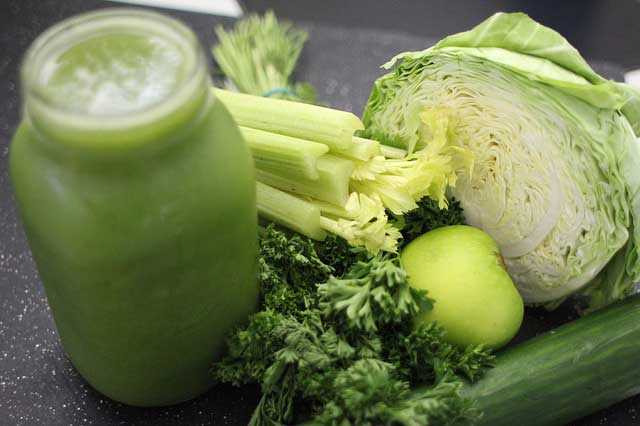
You may have come across recipes calling for the use of celery juice, usually a non-salt sauerkraut recipe. Celery contains natural sodium – nitrate – thus preventing the need for salt. You’ll also see it listed as an ingredient in naturally cured bacon. The use of celery juice for fermentation was made popular by a recipe featured on Dr. Mercola’s website that is designed to sell a starter culture instead of teaching you how to make traditionally fermented sauerkraut.
Celery Juice for Fermentation & Why Some Recommend It’s Use
- A way to make salt-free sauerkraut.
However, the level of sodium in the celery juice is unknown, thus it is hard to know if you’re achieving a 2% brine.
In addition, the recipe I came across calls for the use of a starter to ensure a good ferment.
Celery Juice for Fermentation & Why I Don’t Use It
- Need a juicer.
A juicer is an expensive piece of equipment you may or may not already own. You’re better off putting that money into a crock or a nice digital scale. - Requires an extra step.
And, a labor-intensive step. In my juicer, the celery fibers clog the blades and require frequent cleaning. - Vegetables naturally create their own brine.
Adding salt to sliced vegetables extracts water from their cells and creates the necessary brine and at times more brine that can fit into your jar. - Adds a celery juice flavor to each batch.
- Unknown levels of sodium in the celery juice.
Salt – and the right amount of salt – is essential in establishing a safe fermentation environment conducive to beneficial bacteria and inhospitable to pathogenic bacteria.
How Much Salt Do I Use to Make Sauerkraut?
5. What’s Wrong with Using a Bit of Brine from a Previous Batch of Sauerkraut?
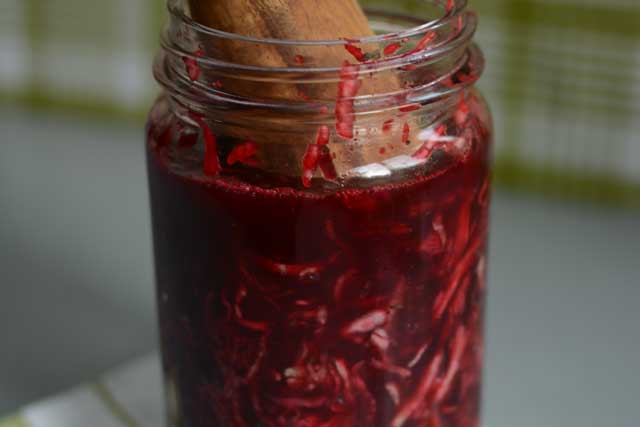
Periodically, someone emails me asking if they can add brine from a previous batch of sauerkraut to their next batch of sauerkraut. I never had a clear answer to that until delving into the use of starter cultures for this post.
Back-slopping, or taking a few tablespoons of brine from a previous batch of sauerkraut, and adding it to a new batch makes sense. After all, why not take advantage of all those good bacteria to help with the fermentation process?
There’s also the question of a reusing a large quantity of brine from a batch of pickled vegetables, like carrots or pickles. Why not just repack the jar with a fresh set of carrot sticks?
Brine from a Previous Batch for Fermentation & Why Some Recommend It’s Use
- Reduce waste.
The best use for any probiotic-rich leftover brine in a jar of pickles or sauerkraut is to drink it (or make a salad dressing with it).
We are slowly seeing fermentation companies promoting exactly that. Gut Shots can now be found on grocery store shelves (refrigerated, it’s live!). There’s even drink recipes calling for its use. Dirty Martini anyone?
Any leftover brine I have just gets dumped into another jar of finished sauerkraut. - Makes sense.
Until you look further into why it really doesn’t. See below.
Brine from a Previous Batch for Fermentation & Why I Don’t Use It
- Alters the stages of sauerkraut fermentation.
The 3 or 4 stages of sauerkraut fermentation are altered when you add brine from a previous batch. If you add the bacteria from the finished ferment, the bacteria at stage 4 of the process, it will be a different product because you are interfering with the first few stages. A lot of the flavor happens in some of these stages. Let them progress as nature intended. - Lowers the acidity of your ferment prematurely.
The pH of the brine from a finished ferment (<4.0 pH) is much lower than the pH of the brine when first packing the cabbage and vegetables into the jar or crock. Different bacteria prefer different levels of acidity. Your ferment has not yet gone through the steps to create that acid environment. - Can result in mushy, flavorless sauerkraut due to the shifting of the fermentation stages.
What to Use Instead of Starter Cultures, Whey, Vinegar, Celery Juice or Leftover Brine?
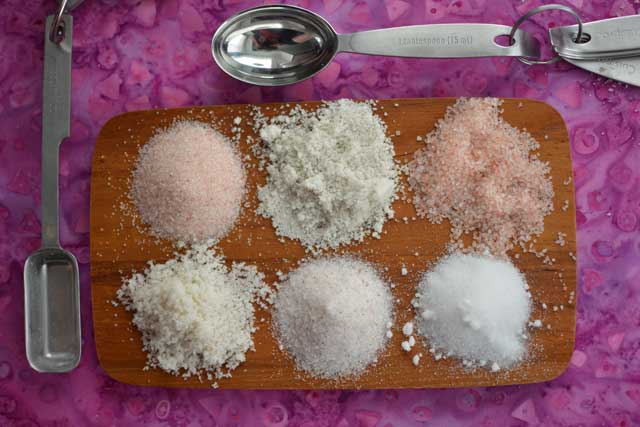
Salt, and Time.
And during this time, it’s the microbes doing the work, not you.
Let them do their job in their own sweet time. Trust in them establish that ideal environment for healthy bacteria, develop a broad flavor profile in your ferment and open your eyes to the incredible and awe-inspiring world of fermentation.
Good-bye to starter cultures.
Here are a set of recipes to get you started:
Sauerkraut Recipes to Please Any Palate
Resources
Can I Use Bragg’s Raw Vinegary in My Brine?
The Crucial Difference Between Fermented and Pickled
Fermented Fruits and Vegetables, A Global Perspective…
The Fermented Food Podcast, Episode 10: To Starter or Not to Starter Culture
Microorganism in Foods 6: Microbial Ecology of Food Communities
Do you agree or disagree about the use of starter cultures in sauerkraut and vegetable ferments? What are your experiences?
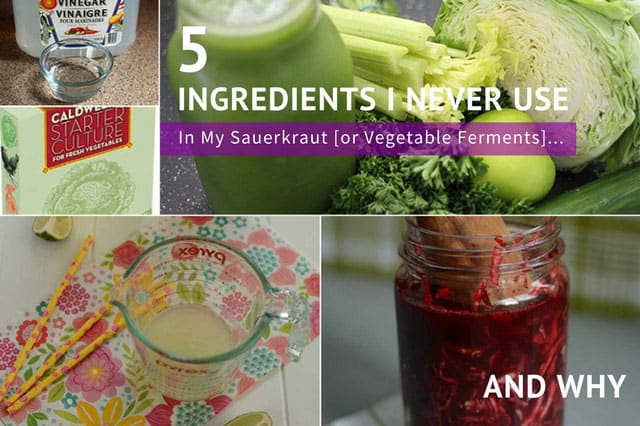
Last update on 2024-07-26 / Affiliate links / Images from Amazon Product Advertising API

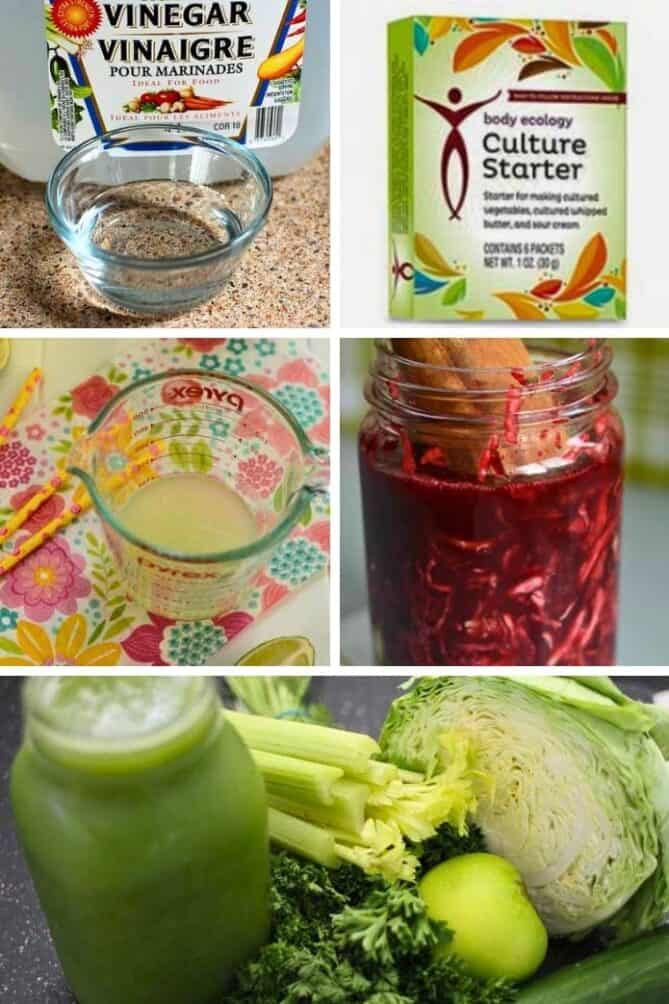

 This post may contain affiliate links which won’t change your price but will share some commission.
This post may contain affiliate links which won’t change your price but will share some commission.


